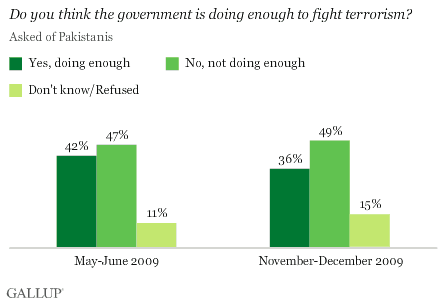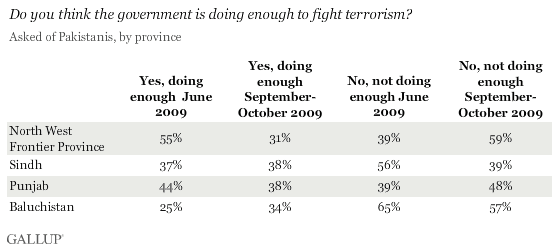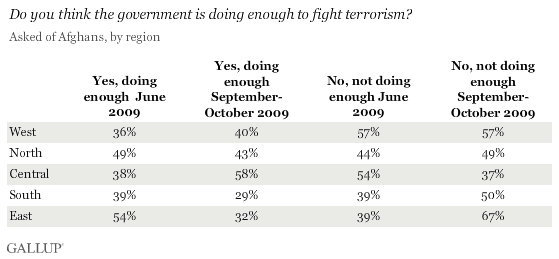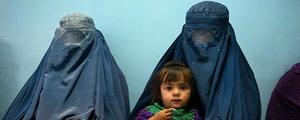This article is the second of a two-part series that looks at Pakistanis' and Afghans' views of the Taliban's influence in their respective countries and efforts to combat terrorism.
WASHINGTON, D.C. -- Despite Pakistan's major military offensives against the Taliban last year, Gallup surveys show Pakistanis' evaluations of their government's efforts to fight terrorism didn't improve -- or change much at all -- in 2009. Nearly half (49%) of Pakistanis surveyed in November and December said their government isn't doing enough, similar to the 47% who said so in May and June.

Pakistanis' views hint at frustration with the lack of meaningful, lasting change after military operations in North West Frontier Province (NWFP) in May and in South Waziristan in October. From Peshawar to Karachi, scores of Pakistani civilians continue to die in militant attacks and suicide bombings, like those last week that claimed nearly 90 lives.
When Pakistanis' opinions did change, they generally drifted in a negative direction or toward uncertainty. During the May offensive, a majority (55%) of those closest to the action in NWFP said the government was doing enough. But after the Pakistani military moved the battle to South Waziristan in October, less than a third (31%) of NWFP residents appraised their government's anti-terrorism efforts this way.

In neighboring Afghanistan, where residents also live under the daily threat of terrorism, the view was much the same. Even with an infusion of troops ahead of the August election, Afghans' grades for their government's efforts to combat terrorism did not change. Half (50%) of Afghans surveyed in September and October said their government isn't doing enough -- essentially unchanged from the 46% who said this in June. Like Pakistanis, Afghans leaned slightly more toward saying the government is not doing enough.

Afghans' evaluations of their government's anti-terrorism efforts varied widely across their country. In the latter half of 2009, Afghans' assessments took a negative turn in the Afghan-Pakistan border regions in the South and East. Afghans' evaluations improved in the Central region, which may reflect the heightened security in the Kabul area ahead of the election and the relatively low risks of violence in other provinces.

Bottom Line
Gallup's surveys show few Afghans and even fewer Pakistanis view the Taliban's presence as a positive influence. Further, particularly in Pakistan's case, offensives against these unpopular militants have done little to change perceptions of the government's efforts to combat terrorism. These findings reinforce how what happens after the battle is over is almost as important as the battle itself -- which may be the key to creating meaningful change in Pakistan and Afghanistan that allows the governments to focus on other issues important to their people. In future articles, Gallup will analyze what these other potential issues are.
For complete data sets or custom research from the more than 150 countries Gallup continually surveys, please contact worldpollpartners@gallup.com or call 202.715.3030.
Survey Methods
Results are based on face-to-face interviews in Pakistan with 1,147 adults, aged 15 and older, conducted in Nov. 14 to Dec. 7, 2009, and 1,133 adults, conducted May 1 to June 30, 2009. For results based on the total sample of national adults, one can say with 95% confidence that the maximum margin of sampling error is ±3.7 percentage points.
FATA/FANA were excluded. The excluded area represents less than 5% of the population. Please note improved sample coverage and change in data collection agency beginning June 2009 measurement. The survey included Azad Jammu and Kashmir, but sample sizes were too small to report results. Maximum margin of error by region in both survey waves ranged from ±6 percentage points in Punjab to ±11 percentage points in Baluchistan.
Results are based on face-to-face interviews with 1,000 adults, aged 15 and older, conducted Sept. 20 to Oct. 12, 2009, and 1,000 adults in June 4-16, 2009, in Afghanistan. For results based on the total sample of national adults, one can say with 95% confidence that the maximum margin of sampling error is ±4 percentage points. Seventeen provinces were randomly chosen from 34 provinces and the sample was adjusted to reflect the population in terms of age, gender, and ethnicity, and rural and urban population. Sample sizes and margins of error for each region were the same in both survey administrations.
North Afghanistan: Results based on interviews with 290 adults from the provinces of Balkh, Kunduz, Sar E Pol, Takhar, Badakhstan, and Samangan. The maximum margin of sampling error is ±7 percentage points.
Central Afghanistan: Results based on interviews with 250 adults from the provinces of Bamiyan, Kabul, Parwan. The maximum margin of sampling error is ±8 percentage points.
South Afghanistan: Results based on interviews with 230 adults from the provinces of Ghazni, Kandahar, Zabul, and Paktika. The maximum margin of sampling error is ±8 percentage points.
West Afghanistan: Results based on interviews with 130 adults from the provinces of Badghis and Herat. The maximum margin of sampling error is ±11 percentage points.
East Afghanistan: Results based on interviews with 100 adults from the provinces of Nurestan and Nangarhar. The maximum margin of sampling error is ±13 percentage points.
The margin of error reflects the influence of data weighting. In addition to sampling error, question wording and practical difficulties in conducting surveys can introduce error or bias into the findings of public opinion polls.
